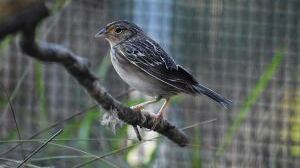BREVARD COUNTY, Fla. — The Brevard Zoo is doing its part to help the critically endangered Florida grasshopper sparrow boost the population of the species.
The breeding season for the endangered sparrow has recently come to an end and the zoo is reporting that nearly 50 sparrows were or will be released into their natural habitat this year.
>>> STREAM CHANNEL 9 EYEWITNESS NEWS LIVE <<<
According to a news release, the Brevard Zoo is part of a collaborative conservation effort to save this species, working with the Florida Grasshopper Sparrow Working Group, Florida Fish and Wildlife Conservation Commission, United States Air Force, U.S. Fish and Wildlife Service and Archbold Biological Station.
Florida grasshopper sparrows are found only in a few areas of Central and South Florida.
Read: Skillet, Zach Williams among ‘Rock the Universe’ headliners at Universal Orlando Resort
In 2021, just over 100 members of their species were found in their natural range.
Breeding season for the Florida grasshopper sparrow begins in the spring when males signal their interest to the females to breed, through a buzzing sound.
According to a news release, the newly hatched chicks stayed with their parents for 21 days and were then moved to another behind-the-scenes habitat at the zoo and monitored to ensure their well-being before release. Once matured and medically cleared, each clutch (or group) of chicks was released onto the prairie in which populations of Florida grasshopper sparrows live in their natural range.
The Brevard Zoo said its first breeding season was extremely successful, due in part to its outstanding conservation team.
Read: Brevard Zoo hatches critically endangered baby chicks to help boost wild population
“Reproduction takes a lot of energy for animals to do,” said Kelly Currier, conservation coordinator for the Brevard Zoo. “If they didn’t have enough of the right plants, space, food or sounds, they may not have reproduced as frequently.”
“Our success means we can further increase genetic diversity on the prairies and help increase the numbers even quicker than before. The sparrows desperately need this boost due to their dramatically low numbers in the past few years,” Currier added.
We are happy to share that our breeding season for critically endangered Florida grasshopper sparrows was wildly successful! 47 birds were released or are soon to be released into their natural range to boost the population of this species.
— Brevard Zoo (@BrevardZoo) September 19, 2022
Learn more: https://t.co/UcPawK4yBE pic.twitter.com/AMgDJFfwZl
Click here to download the free WFTV news and weather apps, click here to download the WFTV Now app for your smart TV and click here to stream Channel 9 Eyewitness News live.
©2022 Cox Media Group















